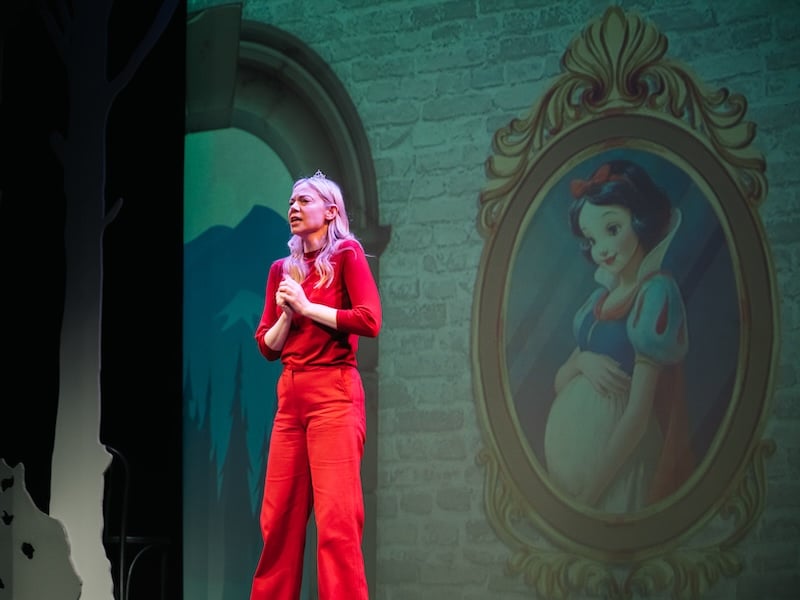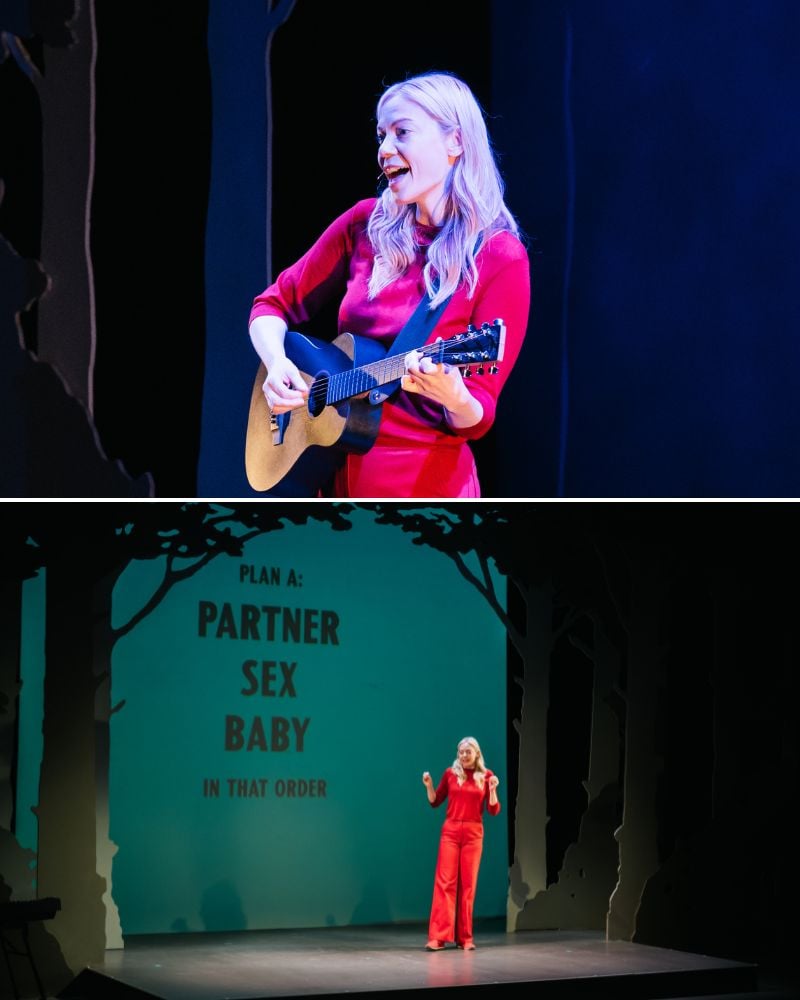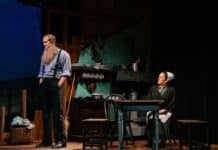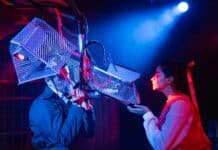Like most shows Woolly Mammoth Theatre Company produces, Dead Inside is multi-layered. Rooted in the traditions of Richard Pryor, Lily Tomlin, Robin Williams, and Lenny Bruce, it is stand-up comedy that is in the process of being shaped into something bigger. If you’re coming for the laughs, you’ll definitely get them: the show is funny as hell. It is also a one-person musical. While that is standard training in an improv class, to the uninitiated, the very idea of a one-person musical comedy is funny. The contrast between the solo performer Riki Lindhome’s Wickedly blonde (movie reference intended) appearance and her sharp insights on her life (and ours) is funny. She’s an occasional writer for Saturday Night Live. So, yes, her material is not only very funny but also honed to a fare-thee-well.
But wait, there’s more. Dead Inside is also shocking, breathtakingly disturbing, pathos-filled, and highly gratifying. On opening night, Lindhome received a well-deserved standing ovation from much of the audience at the conclusion of her performance.

In her notes for the show, Woolly Mammoth artistic director Maria Manuela Goyanes reassures the audience that we are in the excellent hands of a “stellar artist.” This is a good thing because the story Lindhome tells of her “journey” in quest of motherhood is not for the faint of heart. And the language she presents it in is casually profane and serrated like a knife.
I experienced Lindhome’s guidance through narrative as being like the reassuring constraint and laser-sharp focus you get subjected to in an excellent TED Talk. That steady and focused guidance acted as an anchor while she shared with us the personal experience of a sometimes terrifying helplessness, isolation, and rage in the face of a setup that denies women human beings access to resources needed to maintain dignity and to experience agency over their own bodies and lives.
When Riki Lindhome found herself approaching the age where giving birth to a child becomes risky for both herself and her potential child, she began in earnest to take steps to have one before it was too late. She had planned ahead. She had already frozen her eggs. So she thought that she was prepared for the journey. What followed was a rollercoaster experience involving mistakes by physicians, miscarriages, hopes, and disappointments. The journey to achieve her goal of starting a family was filled with things she didn’t know before and it was marked by secrecy and isolation. She also found the journey to be made harder than it needed to be by the misguidance embedded in the mythology in which she was indoctrinated by Disney princesses’ stories and music that she loved.
One of the tasks that Riki Lindhome has undertaken in Dead Inside is to get rid of the secrecy that surrounds in vitro fertilization. “We don’t talk about it. And I think we should,” Lindhome says at one point. As a result, this show is filled with knowledge of things that you may or may not want to know about. Things such as silent endometriosis (where tissue similar to the lining of the uterus grows outside the uterus, often causing infertility but causing no pain and so going undetected for years, until one tries to become pregnant and no one can figure out why they aren’t able to) and uterine scraping (often performed to clear a uterus after miscarriage or abortion).
Another task she undertakes is to abstract from personal experience a different, more useful metaphor for the journey that women undergo. She calls this journey The Infinite Forest.

The show’s set (scenic design by Meghan Graham) is framed by cut-out shadows of trees and vines, which I take to be The Infinite Forest. It is understated and at first seems undistinguished. This set supports the narrative rather than telegraphing it. And as the show progresses, the set acquires weight and symbolism from the narrative. This is why we love set designers.
The lighting (by Luis Garcia) is savvy. Lindhome walks into and out of different “rooms” and psychic spaces while talking nonstop (choreography is by Kat Burns). The lighting creates and dissolves spaces, simulating scene changes and atmospheres almost as invisibly and seamlessly as we experience them changing in animation. This is why we love lighting designers.
The projections of charts of the Hero’s Journey and the Infinite Forest are whimsical and useful. (The Infinite Forest slide got a knowing laugh when the audience realized what it was seeing.) The production elements built on subliminal material in the show rather than literally illustrating it, allowing the work to fill the large theater space without sacrificing intimacy.
Deftly balancing these elements, director Brian McElhaney facilitates intimacy between the performer, the audience, and their shared psychic and spiritual landscape. That’s why we love directors.
Whether a production we see is live or on film or video, and whether we acknowledge it our not, we don’t go to the theater for moderation. We want to see Tosca throw herself off of the parapet to her death. We want to see the crippled Porgy follow Bess to New York City on his goat cart. Dead Inside is a story of immoderate passion told immoderately. Through this show, Riki Lindhome says out loud what many people are not willing to acknowledge they are even capable of thinking. The show prods us to laugh, gasp, and cry and in doing so, at least for the amount of time we spend watching the show, makes it impossible for us to be what the title describes: Dead Inside.
Running time: Approximately 80 minutes, no intermission.
Dead Inside plays through August 3, 2025, at Woolly Mammoth Theatre Company, 641 D St NW, Washington, DC. Tickets ($55-$83, with discounts available and a limited number of PWYW tickets starting at $5 for every show) can be purchased online, by phone at 202-393-3939 (Wednesday–Sunday, 12:00–6:00 p.m.), by email (tickets@woollymammoth.net), or in person at the Sales Office at 641 D Street NW, Washington, DC (Wednesday–Sunday, 12:00–6:00 p.m.). Discount tickets are also available on TodayTix.
The digital playbill is downloadable here.
Dead Inside
Created and performed by Riki Lindhome
Directed by Brian McElhaney
Presented by Ali Wong and Bill Hader
Associate Director: Elizabeth Dinkova
Sound Designer: Sarah O’Halloran
Scenic Designer: Meghan Raham
Choreographer: Kat Burns
Lighting and Video Designer: Luis Garcia
COVID Safety: Masks are optional in all public spaces at Woolly Mammoth Theatre except for a mask-required performance Tuesday, July 22, 8 p.m. Woolly’s full safety policy is available here.




